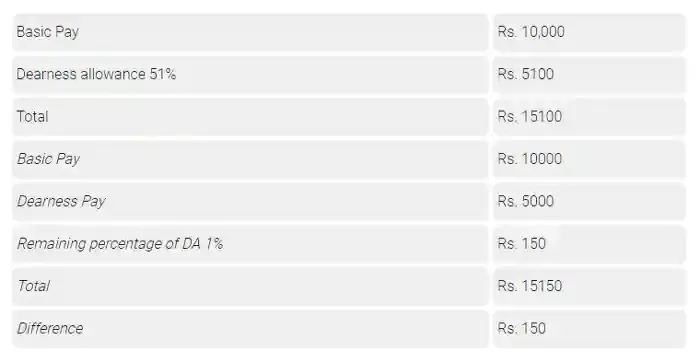7th Pay Commission latest news: Dearness allowance is revised every six months for the employees. But, under the 7th Pay Commission, a condition has been added to it. The condition is that when the dearness allowance of the employees crosses 50 per cent, it will be merged with the basic salary.
The coming days or rather the coming year can be very good for the central employees. Many gifts are waiting for them. From the year 2023 itself, preparations will start regarding the increase in his salary. But, one gift that they will get without any planning is dearness allowance. It is available every year and will continue to be available in the future. But, the twist in the story will come when the year 2024 comes.
From here there will be a tremendous increase in the salary of the employees. There is a reason behind this. The government had issued a notification in the year 2016, stating that if the dearness allowance crossed 50 per cent, it would be made zero for the employees and 50 per cent DA money would be added to the basic salary. Let us understand how much the salary of the employees will increase due to this rule and how the calculation will be done.
Dearness Allowance (DA Hike) will increase by 4 percent in January
Central employees are getting 38 percent dearness allowance from July 2022. Now the next revision is to be in January 2023. Its figures have started coming. The dearness allowance figures from July to September have come. At the end of November, the number of October will also come. It is clear from this that there can be an increase of 4 percent in the dearness allowance next time also.
According to experts, inflation is increasing continuously all over the world. However, steps are being taken to control it in India. Last month, there was a decrease in retail and wholesale inflation. But, global inflation still remains very high. Its effect may still be there. In such a situation, there is only hope of increase in dearness allowance. The figures that are visible so far are pointing towards an increase of 4 percent. If there is an increase of 4 percent in January also, then the dearness allowance will reach 42 percent.
Merger will happen after 50 percent DA
Dearness allowance is revised every six months for the employees. But, under the 7th Pay Commission, a condition has been added to it. The condition is that when the dearness allowance of the employees crosses 50 per cent, it will be merged with the basic salary. And dearness allowance ie DA will be made zero.
When it is 50 percent, the money that the employees will be getting as dearness allowance will be added to the basic salary and the revised salary will be added to the allowance money. The minimum basic salary of a Level-3 employee is Rs 18000. Suppose DA increases to 50%, then the employee will get Rs 9000 as allowance. If we add this amount of 9000 rupees to the basic salary, then the basic salary of the employee will be 27000 rupees. And from here the dearness allowance will be zero.
When does dearness allowance become zero?
When the new pay scale is implemented, the DA received by the employees is added to the Basic Salary. According to experts, according to the rules, the DA received by the employees was added to 100% basic salary. In the year 2016, the government changed the rules. When the sixth pay scale came in the year 2006, at that time 187 percent DA was being received till December in the fifth pay scale.
The entire DA was merged with the basic pay. Hence the coefficient of 6th pay scale was 1.87. Then new pay band and new grade pay were also made. But, it took three years to deliver it. This was also done in the 7th Pay Commission. Now the recommendations of the 8th Pay Commission are to come in 2024, then it is expected to happen once again.
What happened in 5th and 6th pay commission?
At the time of the Sixth Pay Commission in the year 2006, the new pay scale was implemented from January 1, 2006, but its notification was issued on March 24, 2009. Due to this delay, DA Arrear of 39 to 42 months was paid to the government in 3 installments in 3 financial years 2008-09, 2009-10 and 2010-11. A new pay scale was also created. In the fifth pay scale of 8000-13500, 186 percent DA on 8000 was Rs 14500. Therefore, on adding both, the total salary was 22 thousand 880.
In the sixth pay scale, its equivalent pay scale was fixed at 15600 -39100 plus 5400 grade pay. In the sixth pay scale, this salary was 15600-5400 plus 21000 and on adding 16 percent DA 2226 on January 1, 2009, the total salary was fixed at Rs 23 thousand 226. The recommendations of the Fourth Pay Commission were implemented in 1986, the fifth in 1996, and the sixth in 2006. The recommendations of the Seventh Commission came into force in January 2016.
How much does the salary increase when DA is zero?

Automatic revision will happen in HRA
The next revision in House Rent Allowance will also happen when Dearness Allowance will cross 50 per cent. There is to be an increase of 3% in this. At present, the maximum rate is 27 per cent, which will be increased to 30 per cent. According to the government memorandum, HRA will be 30%, 20% and 10% when DA crosses 50%. The category of House Rent Allowance (HRA) is divided into X, Y and Z class categories. It has a list of cities. The central employees who fall in the X category have 27 per cent HRA, 18 per cent for Y class and 9 per cent for Z class HRA at present. There has to be a revision of 3-3% in this.














